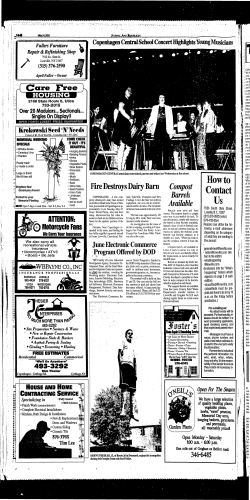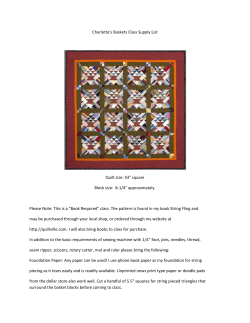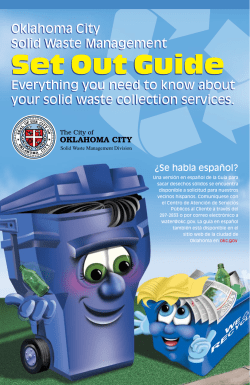
Food Service Composting Guide
COMPOSTING The food service guide to keeping compostables out of landfills Green Mountain Compost Why composting matters to your business Add up spoilage, trimmings and plate scrap- ings, and your kitchen or restaurant is probably generating about a pound of food “waste” for every person you serve.* Waste of any kind means lost profits and opportunity, and that’s an expense we can help you avoid while setting you up to be in compliance with Act 148, Vermont’s universal recycling and composting law. Starting in 2014, Act 148 bans food scraps from the landfill, requiring them to be separated from trash on the following schedule, depending on how much you generate: July 2014: 104 tons per year (10-12 68-gallon carts per week) July 2015: 52 tons per year (5-6 carts per week) July 2016: 18 tons per year (about 1 cart per week) July 2020: All food scraps, including from households, are banned from landfill disposal Composting is one of several options. Vermont’s “Food Recovery Hierarchy” (see graphic below) shows ways to slash your landfill-bound trash by applying the 3 R’s — Reduce, Reuse, Recycle — to your food stream. Vermont Food Recovery Hierarchy Source Reduction where this guide comes in. We’ll take you step-bystep through setting up and executing a successful collection program. Your food scraps can then be used for on-site gardens, donated to local farmers, or will go to Green Mountain Compost in Williston to become rich compost and other soil amendments. See the resource list at the end of this guide for more info about reducing waste and donating leftovers. More bottom-line benefits: • Up to two-thirds of what you’re throwing out with your trash may be food scraps and compostable paper. Donating and/or composting that material, rather than sending it to the landfill, will save diesel fuel, reduce air pollution and truck traffic, and possibly reduce your trash service costs. The landfill is 70 miles away; donation and composting options are right here in Chittenden County. • Food scraps take decades to break down in a landfill, and in the process produce methane, a greenhouse gas that’s 21 times more harmful to our atmosphere than carbon dioxide. • Studies show that letting your customers know that you donate and/or compost your food scraps can boost customer loyalty and employee morale. Food for People Food for Animals Composting & Anaerobic Digestion Energy Recovery Step 1: Reduce waste system-wide. Stop waste where it happens: purchasing, prep, and service. Step 2: Repurpose/reuse food and scraps. Donate usable food to a food shelf, and scraps to farmers to feed pigs and chickens. Step 3: Recycle food and scraps as compost! That’s *”Too Good To Waste,” 2010 Sustainable Restaurant Association survey results of a cross-section of 10 London, England restaurants averaging 145 to 3200 covers/week. These carrots were buried in a landfill for ten years next to newspapers that were still readable! At Green Mountain Compost, food scraps become a valuable soil amendment in just a few months. Setting Up Your Program 1. Identify where you generate waste • Prep stations — all food trimmings: peelings, meat, dairy, fruits, and vegetables •C ooking — burned or mishandled food •C ooler — spoilage • Buffets — unrecoverable leftovers •C ustomers — scraps, leftovers, paper napkins 2. E stimate average weekly volume. Typical commercial trash cans range from 33 to 64 gallons, with the capacity often stamped on the side or bottom. For one week, designate one or two trash cans for food and soiled paper only, and keep track of how many you fill. number of carts and frequency of service. Since food scraps will no longer be in your trash, you may be able to reduce your trash dumpster size and/or pickups after you see the results of separating compostables for a month. 5. Get free help: Collection buckets, signage, and training. See the last page of this guide for free resources CSWD can provide. 4. Set Up Your Kitchen Buckets et staff suggestions for key spots where food G scrap collection buckets should be placed, as well as locations for informational signs. 3. C ontact your trash and recycling hauler for a service estimate. Negotiate your Food Service Compost Haulers pickup schedule and fees with your waste hauler before you launch your program. Haulers provide 32- or 68-gallon lidded, wheeled carts in your outdoor trash/recycling area, with pickups one or more times per week. Fees are based on the Casella Resource Solutions: 802-864-3615 Gauthier Trucking: 802-879-4020 Kimbell Compost: 802-356-3573 Myers Container: 802-655-4312 “It’s a piece of cake. Ensure Success! Once we started, we couldn’t believe we hadn’t been doing this before.” — Best Western Windjammer General Manager Dan Phelan Get staff input • Actively solicit staff suggestions at every step. • They’ll often see potential for improvements that could save you time and money, and they’ll feel more invested in the program. Run through the system to address any food safety or ergonomic issues. • Make sure all employees understand the steps and requirements. • Include food scrap management training in all new-employee orientations. Set up a test run • Start the program on slower shifts or with preconsumer food trimmings for the first few months. Once that’s dialed in, add busy shifts and leftovers from customers’ plates. food scrap bins? If so, you must remove it before the compost cart is picked up. Contaminated loads may be rejected by your hauler or by Green Mountain Compost. Announce and educate • Is there any trash or recycling being put in the Collect data • Track the number of outside carts filled daily or • • weekly so you know how much food you’re keeping out of the trash. Check your trash dumpster right before it’s serviced. If it isn’t full, get a smaller dumpster or reduce your service frequency! Share data with staff and the hauler contract negotiator so they understand the positive impact they’re having on your waste stream. Monitor and tweak the system • Do bucket locations make sense? Are they being emptied regularly? See last page for FREE Resources Free Resources Help when and where you need it: • Technical assistance and training CSWD staff is available to help you plan a system that will work for your business, from waste assessment to collection to negotiating and managing pickup. • Purchasing guidance If you’re thinking of purchasing compostable food serviceware, check with CSWD to make sure the products deliver on your vendor’s claims and are acceptable at Green Mountain Compost. • Collection buckets and signage CSWD can provide labeled 4-gallon buckets (shown here) for kitchen scrap collection, or just the labels to use on buckets you may already have. Many kitchens color-code their buckets for instant recognition. • CSWD signs will quickly answer what can and can’t Key Questions • I s this okay with my Health Inspector? Yes! Separating food scraps for compost pickup is completely acceptable as long as you follow Health Department waste management guidelines. See the attached Fact Sheet for details. If your inspector says your compost pickup is in violation, please contact us at biz@cswd.net or 802-872-8100 x237 with the details and we’ll help you troubleshoot. • H ow can I manage odors? Properly managed, your food scrap collection area will not smell worse than your normal trash. Monitor your waste area and carts to make sure they’re being maintained by your staff and your waste hauler. Inside, run collection buckets through your dishwasher or wash by hand at end of every shift. Outside, add sawdust, lime or newspaper on freshly added food scraps to suppress odors and fruit flies. go into the compost bin. We’ll provide a pdf file for you to print, or up to three durable signs per site. Food Waste Prevention and Donation Resources EPA.gov — Search “food waste prevention” to get hands-on tips, waste calculators, audit logs and many other useful tools for commercial kitchens. restaurant.org — Search “food costs” for proven money-saving ways to slash food waste. vtfoodbank.org — Search “donate food” for local contacts, tax benefits, and liability information. Contact us to get started today! 802-872-8100 x 237 • biz@cswd.net www.cswd.net 1021 Redmond Rd., Williston, VT 05495 Printed on 100% post-consumer recycled paper 12/13 What Goes Where In the Kitchen Recycling Must be empty and free of food • Clean, uncoated paper • Unwaxed/uncoated cardboard, clean pizza boxes • Clean aluminum foil, cans, pie plates • Empty metal food/drink cans, rinsed • Empty metal spray-oil cans (such as Pam) • Empty, rinsed plastic food and drink jugs, buckets and bottles • Empty glass food and drink bottles and jars Compostables • ALL food & beverages, bones, peelings, seeds, rinds, etc. • Coffee grounds & filters • Tea bags • Soups & sauces • Dressings & condiments • Cooking oils & grease in small amounts — must be cooled • Food-soiled paper towels, napkins, tissue & newspaper • Greasy take-out pizza boxes • Paper egg cartons • Uncoated paper bags & plates • Wooden or bamboo utensils • Certified compostable cups, plates, bowls, takeout containers and utensils. Item or its packaging MUST have this symbol Trash • Bottle caps • Plastic bags, plastic wrap of any kind • Waxed or coated paper • Styrofoam • Stickers & sticker backing • Paper drink & soup cartons • Butter foils & papers • Sugar, salt & pepper packets • Straws (unless certified compostable) • Food service gloves & hairnets Got a question about which container something should go in? Contact CSWD! 872-8111 • info@cswd.net or visit www.cswd.net
© Copyright 2025











